
Isabella d'Este was Marchioness of Mantua and one of the leading women of the Italian Renaissance as a major cultural and political figure. She was a patron of the arts as well as a leader of fashion, whose innovative style of dressing was copied by numerous women. The poet Ariosto labeled her as the "liberal and magnanimous Isabella", while author Matteo Bandello described her as having been "supreme among women". Diplomat Niccolò da Correggio went even further by hailing her as "The First Lady of the world".

Mantua is a city and comune in Lombardy, Italy, and capital of the province of the same name.

The House of Gonzaga is an Italian princely family that ruled Mantua in Lombardy, northern Italy from 1328 to 1708. They also ruled Monferrato in Piedmont and Nevers in France, as well as many other lesser fiefs throughout Europe. The family includes a saint, twelve cardinals and fourteen bishops. Two Gonzaga descendants became empresses of the Holy Roman Empire, and one became queen of Poland.

Ludovico III Gonzaga of Mantua, also spelled Lodovico was the ruler of the Italian city of Mantua from 1444 to his death in 1478.
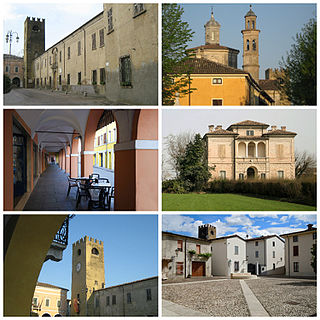
Castel GoffredoItalian pronunciation: [kaˈstɛl ɡofˈfreːdo] is a comune in the province of Mantua, in Lombardy, northern Italy, 35 kilometres (22 mi) from Mantua and a few more from Brescia. It lies in a region of springs at the foot of the slopes that drain into Lake Garda, towards the plain of the Po. Castel Goffredo borders the following municipalities: Castiglione delle Stiviere, Medole, Ceresara, Casaloldo, Asola, Acquafredda, Carpenedolo.

The Golden Ambrosian Republic was a short-lived republic founded in Milan by members of the University of Pavia with popular support, during the first phase of the Milanese War of Succession. With the aid of Francesco Sforza they held out against the forces of the Republic of Venice, but after a betrayal Sforza defected and captured Milan to become Duke himself, abolishing the Republic.

Cabiate is a comune (municipality) in the Province of Como in the Italian region Lombardy, located about 20 kilometres (12 mi) north of Milan and about 20 kilometres (12 mi) southeast of Como.

Federico I Gonzaga was marquess of Mantua from 1478 to 1484, as well as a condottiero.
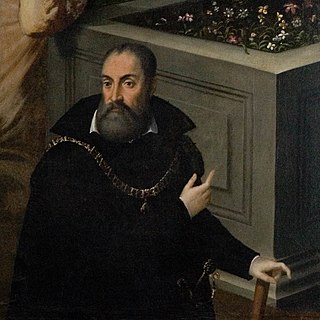
Ferrante I Gonzaga was an Italian condottiero, a member of the House of Gonzaga and the founder of the branch of the Gonzaga of Guastalla.

Leone Leoni was an Italian sculptor of international outlook who travelled in Italy, Germany, Austria, France, Spain and the Netherlands. Leoni is regarded as the finest of the Cinquecento medallists. He made his reputation in commissions he received from the Habsburg monarchs Charles V, Holy Roman Emperor and Philip II of Spain. His usual medium was bronze, although he also worked in marble and alabaster, carved gemstones and probably left some finished work in wax, as well as designing coins. He mainly produced portraits, and was repeatedly used by the Spanish, and also the Austrian, Habsburgs.

La Bella is a portrait of a woman by Titian in the Palazzo Pitti in Florence. The painting shows the subject with the ideal proportions for Renaissance women. In parallel the stringent composition corresponds to Titian's real portraits. The work can be dated by a letter about "that portrait of that woman in a blue dress" in May 1536.

Portrait of Francesco Gonzaga is a painting by Italian Renaissance artist Andrea Mantegna. It is now at the National Museum of Capodimonte, Naples, Italy.

Portrait of Federico II Gonzaga is a painting by Titian, who signed it Ticianus f.. Today in the Museo del Prado, Madrid, it portrays Federico II, Duke of Mantua who married in 1529; the portrait may have been commissioned for the occasion. The dog, a Maltese, is a symbol of faithfulness.
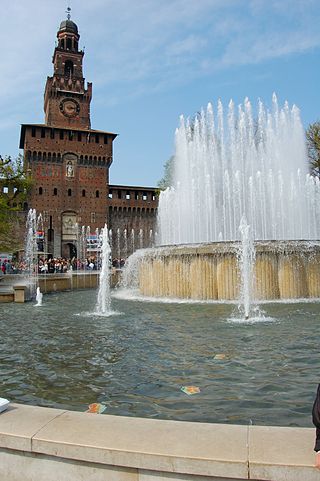
The Applied Arts Collection of Milan is located in the Sforza Castle museum complex under the management of the municipality of Milan, Italy. The museum is divided into several sections with particular emphasis on jewelry, ivories, pottery and art glass.

Margherita Malatesta of the House of Malatesta was the wife of Francesco I Gonzaga of the powerful House of Gonzaga, the ruler of Mantua in Northern Italy, whom she married in 1393. They were already related through the marriage of his sister, Elisabetta, to her brother, Carlo. Francesco's first wife Agnese Visconti had been executed for infidelity in 1391. Margherita and Francesco I were the parents of Gianfrancesco I the first Marquis of Mantua. Gianfrancesco married Paola Malatesta, daughter of Malatesta IV, in 1409.

The flag of Lombardy is one of the official symbols of the region of Lombardy, Italy. The current flag was officially adopted on 4 February 2019, although it has been used de facto since 12 June 1975.
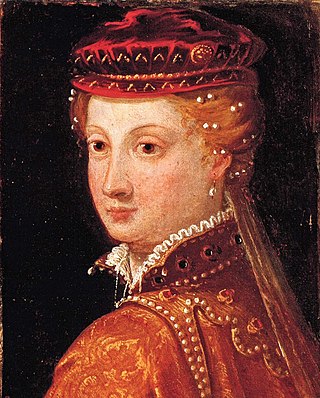
Paola Agnese Malatesta also Paola of Mantua was an Italian noblewoman of the noble family House of Malatesta, rulers of Rimini and Pesaro. She was born in Pesaro in 1393 to Malatesta IV Malatesta, lord of Pesaro and Fossombrone, and Elisabetta da Varano. On 22 August 1409 she married Gianfrancesco Gonzaga, leader of Mantua, in Pesaro. She was the first Marquesa of Mantua after her husband received the title. Paola had six children. This union introduced the genetic disease of kyphosis to the Gonzaga family which showed in subsequent generations.
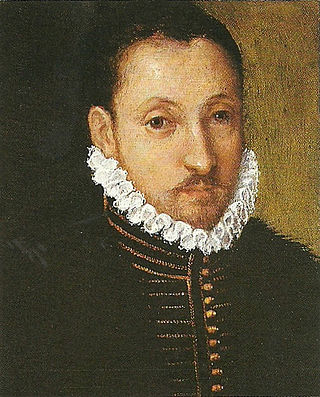
Ferrante or Ferdinando Gonzaga, first marquess of Castiglione was an Italian nobleman and condottiero.

















